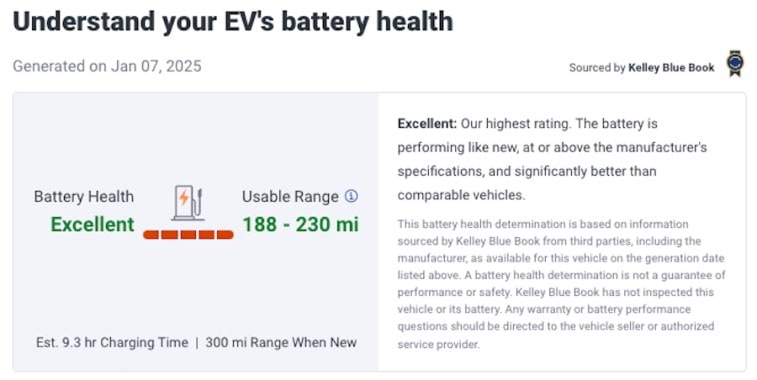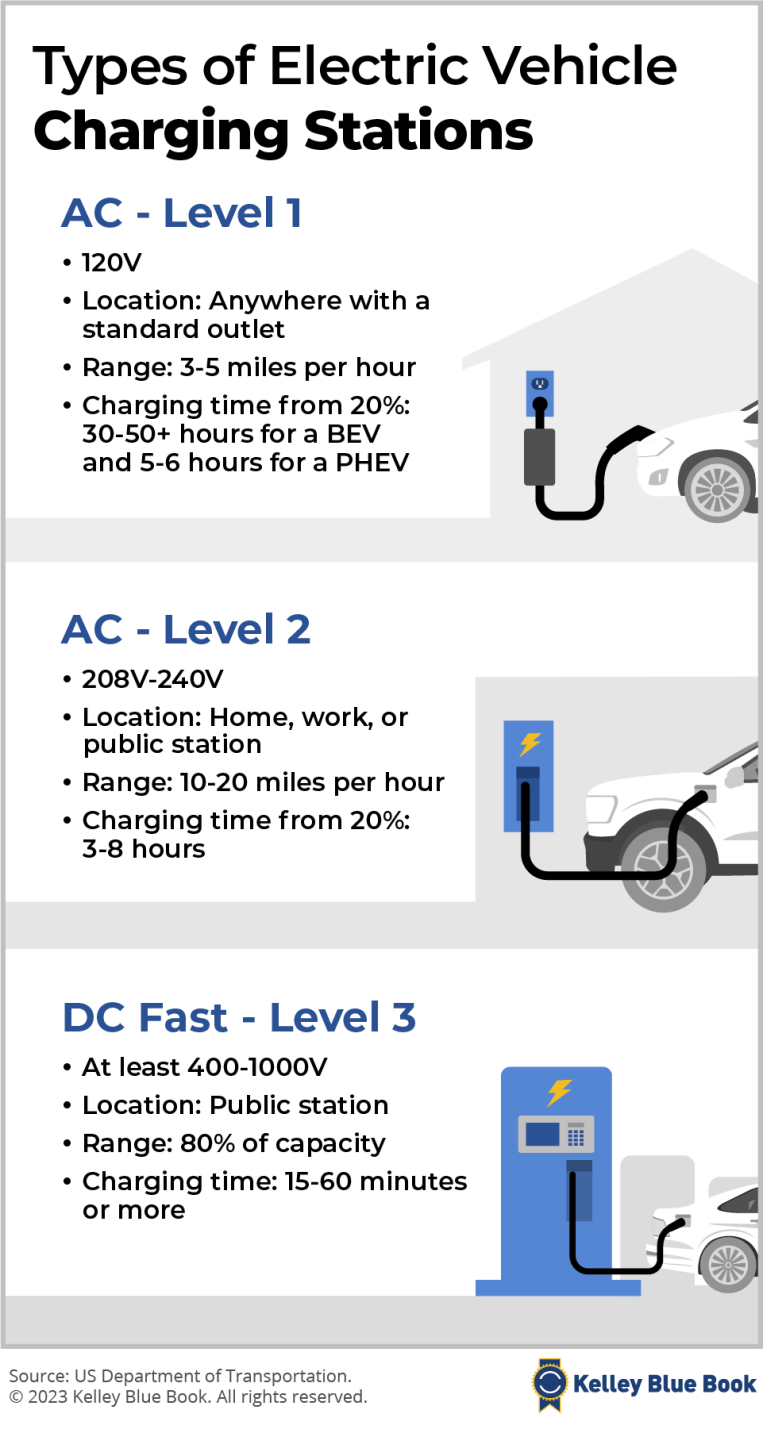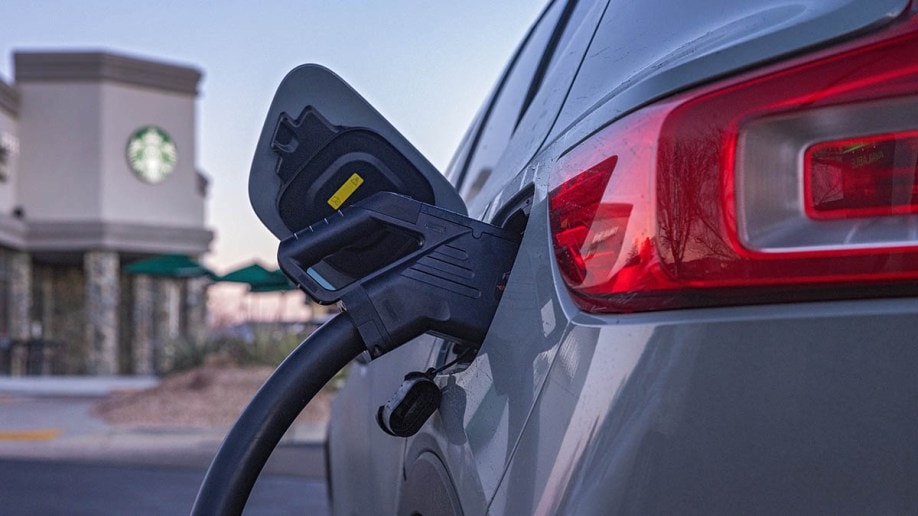Quick Facts About Used Electric Cars
- Consider the total cost of ownership, including fuel and maintenance savings, when determining the vehicle’s value.
- Research the EV’s battery health and confirm the remaining warranty coverage before buying a used electric car.
- Determine your daily range needs and pay attention to the vehicle’s charging rate.
Buying a used electric car may seem intimidating at first, especially if you’ve never owned an EV. Electric cars require some different thinking compared to gasoline- or diesel-fueled vehicles. There are some extra things to consider when looking at a used electric vehicle. Still, the used electric car market is growing as current owners trade-in and up, but availability can be tight. The current high demand for used EVs is fueled by more affordable prices and increased consumer confidence in their reliability.
Read through these pros and cons of buying a used electric car, and review our guide to purchasing a used EV below to help you determine if it’s the right decision for you.
Benefits of Buying a Used Electric Car
- Operating Savings: Electric vehicles typically have lower operating costs compared to their gas-powered counterparts. You’ll save money on fuel and regular maintenance expenses.
- Upfront Savings: EVs depreciate faster than gas-powered cars. The initial loss in value means that cost-conscious consumers can buy slightly used electric cars at a notable discount.
- Energy Efficiency: The motor in an electric vehicle is more efficient than those in gas vehicles since they convert electric energy to power your car more effectively.
- Government Incentives: As part of the Inflation Reduction Act, the federal government offers tax credits to some buyers when they purchase certain electric vehicles. Many state and local governing authorities also provide rebates and incentives to help cover the costs of operating an EV.
- Quiet Performance: Electric vehicles offer a smooth and quiet driving experience. There’s no engine sound to account for, and instant torque delivery means you’ll accelerate with less noise.
- Newer Technology: New electric vehicles are popping up on the market each year, and they contain emerging technologies and innovative features.
Drawbacks of Buying a Used Electric Car
- Driving Range: Range is a consideration for all vehicles. In an EV, instead of understanding how far you can drive on a full tank, you’ll have to consider how long you can travel on a full charge. If you plan to use the vehicle for regular road trips, you may have to refuel more frequently.
- Charging Infrastructure: Charging stations are relatively easy to find in populated areas, like shopping centers, grocery stores, and office parks. However, if you don’t have a charging station established at home, relying on these public chargers may become more of a chore over time. Installing a home charger requires a dedicated outlet wired by a licensed electrician. This can be a costly upfront expense.
- Charging Time: Refueling at a gas station usually only takes a few minutes, but recharging an electric vehicle can take much longer. Level 2 charging stations take a few hours to fill an empty battery, which many owners to at home overnight. Fast chargers still take about 20 minutes to boost your battery from 20% to 80%. This can be inconvenient when you’re short on time.
- Battery Lifespan: The performance and overall range of EV batteries can degrade over time. If this happens, you’ll experience reduced driving range. Replacing the battery can be prohibitively expensive.
Here’s a look at some essential things to consider when purchasing a used electric vehicle.
Buying a Used Electric Vehicle: A Step-by-Step Guide
- Use the Battery Life as a Bargaining Chip
- Find Out if the Battery Was Replaced
- Investigate How Much Battery Warranty Is Left
- Ask About Maintenance History
- Locate the Battery’s Charging Capacity
- Determine What Range You Need From the Used EV
- Know That Not All Electric Vehicles Charge at the Same Rate
- Consider Your Access to EV Chargers
- Research Government and Utility Incentives
- Check for All Charging Accessories
1. Use the Battery Life as a Bargaining Chip
Just like a mobile phone, a laptop, or even a TV remote, an electric car’s battery begins to degrade over time, no matter how often the battery is used. Significant heat can accelerate this process, as do repeated charge and discharge cycles. EV batteries typically last between eight and 15 years. The federally mandated minimum warrant coverage is eight years or 100,000 miles.
Ask the seller for a battery health report. If buying from a dealership, its service department can give you a detailed report on battery health. Some models have specific battery health meters. Alternatively, you can charge the used electric car to 100% and then see what the estimated range says. Comparing this to the original rating will give you an idea of what’s left.
Most newer EVs have specific health meters onboard that can be reviewed at a glance, either in the instrument cluster or on the central display screen.
Nobody expects a 100% battery life report on a used electric car, but don’t be dismayed if the vehicle only offers three-quarters of its original range. Most drivers don’t add more than 40 to 50 miles to an odometer a day anyway. If you’re buying a used electric car for your commute, a shorter range may be just fine.
If nothing else, it’s a bargaining point if the battery is not new.
Kelley Blue Book EV Listings With Battery Health Data


Kelley Blue Book has VIN-specific battery health data on many used EV listings on the site. Providing battery health on listings gives shoppers confidence when shopping for used electric cars online.
MORE: Electric Cars 101: Everything You Need to Know
2. Find Out if the Battery Was Replaced
Battery failure may be rare, but it does happen. Higher-mile electric cars are more likely to have had their battery packs replaced entirely.
If this has happened — and the seller can provide documentation confirming the work — it’s a major coup. It means that someone before you went through the effort and expense of having this job performed.
Look at any documentation closely to ensure you’re being handed receipts for the car you want. Also, look at the estimated range on a full charge, and battery health reports on the car’s computer can tell you.
Even if the dealer or seller doesn’t know if the battery got replaced, there’s a chance Carfax or AutoCheck vehicle history reports documented the service. Asking for one is always good practice.
TIP: Electric cars use conventional 12-volt batteries like those found in gas cars (though it is typically much smaller). Batteries power accessories such as the radio and power windows. They might last four or five years before needing replacement. Fortunately, they are relatively inexpensive and can be replaced in a few minutes using basic tools.
3. Investigate How Much Battery Warranty Is Left
Yes, we’re still talking about batteries, but there may be some good news this time. All mainstream automakers included more extended warranty coverage for battery packs than they did for the rest of the vehicle. Many used electric cars will still be under warranty. But read the fine print.
Most battery coverage runs for eight years or 100,000 miles after the initial purchase, whichever comes first. However, not all warranties are transferable to subsequent owners, and they can also vary from model year to model year.
Your best bet is to contact the automaker’s customer service department with the vehicle identification number (VIN). You can find this 17-digit number in several places on the car, and any dealer or previous owner can give it to you.
The customer service department can tell you when the warranty expires and whether it is transferable.
4. Ask About Maintenance History
We always suggest asking a previous owner or a dealer about maintenance history, especially for any service records they can provide.
But electric cars require relatively little maintenance outside of regular tire rotations and windshield wiper replacements, so you may receive very few receipts. Even brakes tend to last much longer on EVs because the regenerative braking systems that help slow the car simultaneously charge the battery.
Also, be sure to use Kelley Blue Book’s tool to know what recall items may affect your used electric vehicle purchase.
RELATED: Recalls 101: What You Need To Know To Stay Safe
5. Locate the Battery’s Charging Capacity
Gas-fueled cars tend to be updated by their manufacturers every few model years, perhaps with a significant redesign every six years. Electric cars? Not so much. Automakers tend to make more incremental changes, especially Tesla.
The most significant change — and the one that can affect a used electric car’s battery — is an increase in battery capacity. Tesla doesn’t use model years for its updates; you’ll want to view the car’s information through its touchscreen. For other automakers, the VIN holds information that a dealer can provide regarding configuration.
It can provide what’s obvious, such as colors, upholstery choices, and the like. The dealer can tell you if the car comes equipped with faster charging capability and can determine the battery’s original capacity.
6. Determine What Range You Need From the Used Electric Car
Electric car development has sped up considerably during the past decade. Early electric cars were lucky to hit 100 miles on a full charge, while today’s Tesla Model S can reach over 400 miles, according to Environmental Protection Agency (EPA) estimates. Future electric vehicles are likely to surpass that number.
Figure out just how much range you need. While 400 miles seems right, electric cars with this range come with a hefty price tag. Suppose you plan to use your electric vehicle for commuting; a vehicle with a range of fewer than 100 miles may work, but a 200-mile range is more than sufficient for a daily driver. For longer drives, you can rent a car, too. This effective strategy saves money in the long run for many drivers.
The most recent data from the U.S. Department of Transportation shows the average driver travels less than 40 miles daily. If you’re able to recharge while parked overnight at home, you might not require as much battery range as you might think.
RELATED: Electric Car Range: Everything You Need to Know
7. Know That Not All Electric Cars Charge at the Same Rate
Electric cars don’t necessarily charge at the same rate, and bigger battery packs usually mean more time to charge. For instance, earlier Nissan Leaf electric cars offered a 6.6-kW onboard charger as an extra-cost option on the base S trim level. Without this charger, Level 2 top-off can take twice as long. Newer electric vehicles and their batteries will top off their charge much quicker.
If you plan to top off your electric car at work or bank on regular, brief visits to public charging stations, consider an electric vehicle that charges quickly. If you can charge overnight at home or all day at work, this may not be a significant factor, and it may mean you can save money with a cheaper used electric car.
MORE: Electric Car Buying Guide: How to Buy the Right EV
8. Consider Your Access to EV Chargers


When buying a used electric car, you’ll want to find out where to access EV chargers along your typical and not-so-typical driving routes. A map of charging stations from the U.S. Department of Energy’s Alternative Fuels Data Center shows more than 70,000 locations across the country.
Here’s what you need to know about EV charging.
Level 1: This level uses household three-prong outlets, like those your computer or a desk lamp use. Few electric car users charge their vehicles this way simply because of how long it takes. A Chevy Bolt EV, for instance, adds about four miles of range per hour this way. This can suffice if you only need to add 20 or 30 miles of charge while at work.
Level 2: Most people prefer Level 2 charging capability. These chargers provide 240 volts of power and require an external device that plugs into a receptacle like an electric clothes dryer. For example, Level 2 can add 25 miles of charge per hour to a Chevy Bolt EV.
Level 3: Also called a DC Fast Charger, the fastest-charging option is a Level 3 charger. These quick chargers can add 160 miles of range to a Chevy Bolt EV in an hour. But you will only find Level 3 options in public charging stations that typically cost money to use.
That’s why a Level 2 charger makes the most sense to invest in for your home. But even then, you need to consider where at home you can charge your car. Suppose you can park in a private garage or a driveway. In that case, you should have no problem having an electrician install the charger.
But if you park on the street or in an apartment garage, you probably can’t charge your electric car at home.
RELATED: An EV Charger Buying Guide: See All Your Options
9. Research Government and Utility Incentives
While most electric car tax rebates apply to new vehicles, some incentives apply to used electric cars. You can also check with your tax preparer or your local motor vehicle office about any specific deals that may apply to you. For 2025, buyers may be eligible for a tax credit of up to $4,000 for qualifying EVs. The sale price must be $25,000 or less and must be at least two model years older than the current calendar year. Income limits apply, and private sales are excluded.
Additionally, some utility providers offer discounted charging equipment and lower rates for charging during off-hours.
Related: How Do Electric Car Tax Credits Work?
10. Check for All Charging Accessories
Once you’ve picked out the electric car you want to bring home, make sure that the seller includes any charging cables. Manufacturers included charging cords with most EVs years ago. In newer models, portable chargers may have been optional accessories. A new portable Level 2 charging cable costs around $300, so it’s worth asking the seller for it so you can recharge when you’re parked at home.
Should You Buy a Used EV?
Buying a used electric car can offer notable advantages, including price savings compared to a new EV, lower operating costs, energy efficiency, and potential government incentives. However, it’s essential to carefully consider factors such as battery lifespan, charging opportunities, and personal driving needs. Before making a purchase, thoroughly research its battery health, the vehicle’s history, remaining warranty coverage, and charging compatibility. By thoroughly evaluating these factors buyers can make an informed decision that balances cost savings and long-term practicality.
Editor’s Note: This article has been updated for accuracy since it was originally published.


